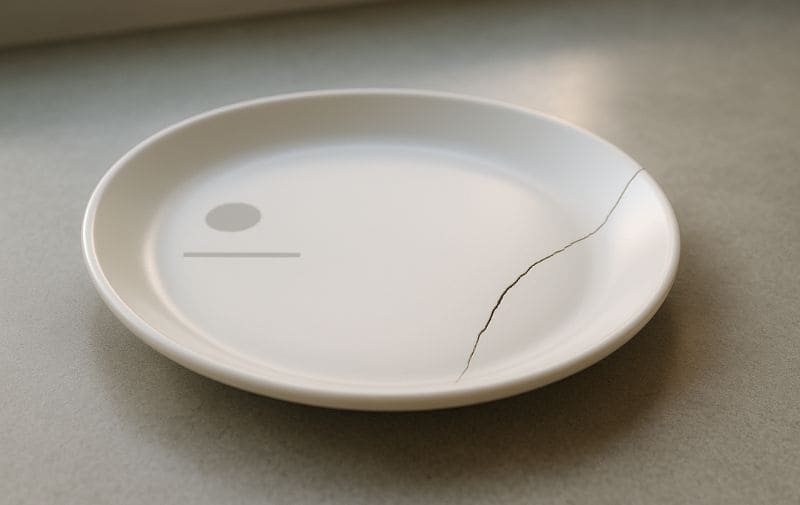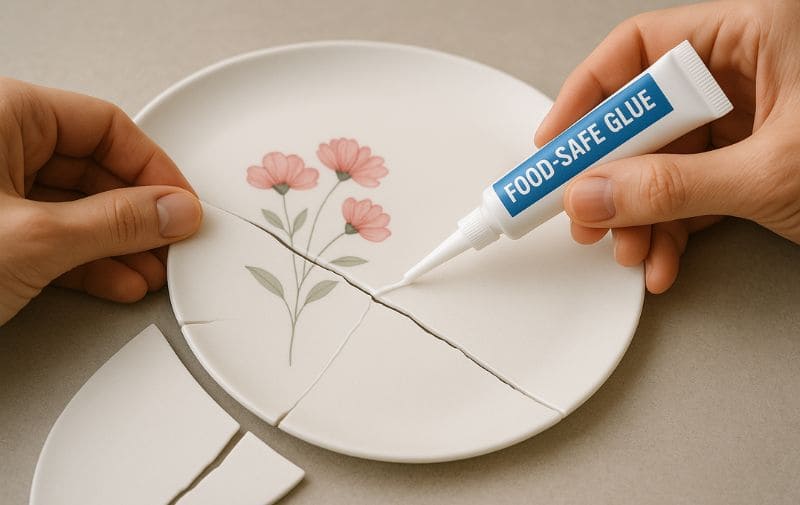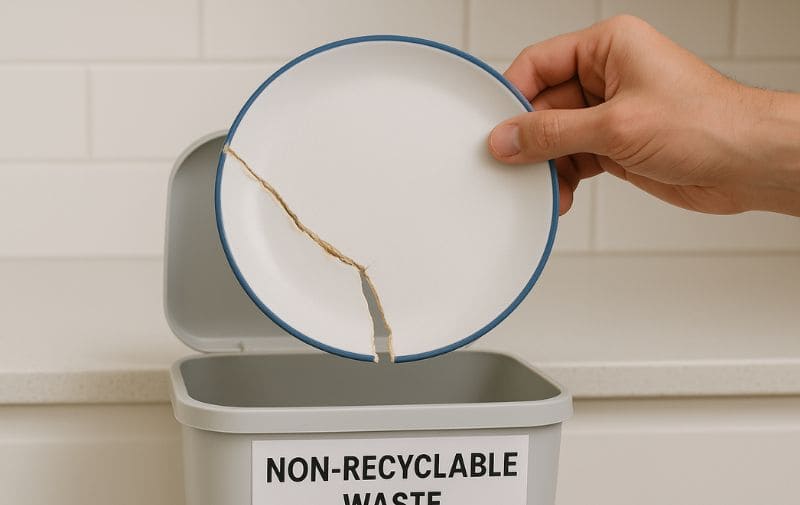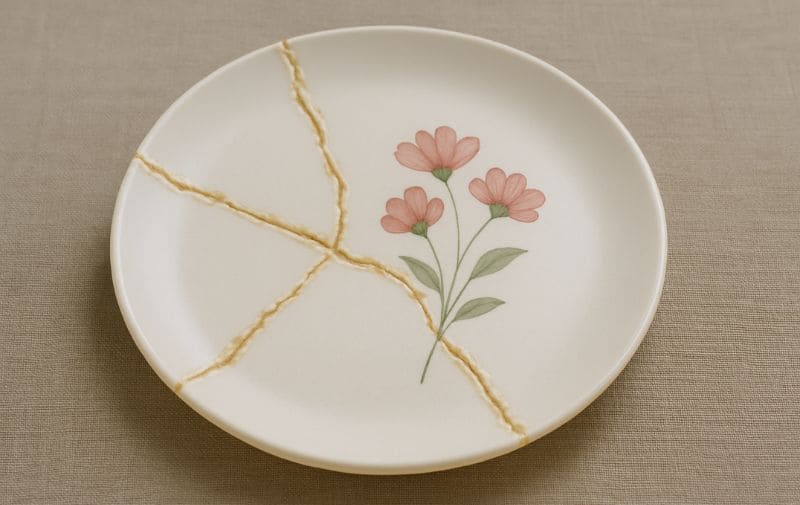It’s a sickening sound—the sharp crack of a plate hitting the floor. You thought your favorite melamine plate was indestructible, but now it’s in pieces. Your first instinct is to find some super glue and fix it. But can you? And more importantly, should you?
No, you cannot safely fix a broken, chipped, or cracked melamine plate for food use. Once the surface is compromised, no glue or filler can make it food-safe again. The only safe “fix” is to retire the plate from food service and repurpose it for decorative use only.
I know that’s not the answer you wanted to find. I’ve seen the same DIY articles and videos you have, promising a quick fix with epoxy or plastic filler. But after decades in the dinnerware industry, I have to give you the blunt, honest truth. Those fixes are a food safety nightmare waiting to happen. Before you reach for the glue, let me walk you through the science of why melamine plates can’t be repaired for food use, what you can do to restore worn plates, and how you can give your broken favorite a new, safe life.
Last Updated: July 2th 2025 | Estimated Reading Time: 15 Minutes

The Core Question: Can You Really Fix Broken Melamine?
Let’s get straight to the point. Is there a magic glue or a secret technique to make your broken melamine plate whole and safe again?
No. For any food-related purpose, a broken melamine plate cannot be safely repaired. The moment it cracks or chips, its non-porous, food-safe surface is permanently destroyed, and it must be immediately retired from the dinner table.
This might seem extreme, especially since melamine is known for being so durable. I’ve had customers tell me their plates have been dropped countless times without a scratch. But “durable” doesn’t mean “indestructible.” Accidents happen, and when they do, the damage is more than just cosmetic. The core reason you can’t truly fix it lies in the very nature of the material itself. It’s not like gluing a piece of wood back together. To understand why, we need to look at what happens on a molecular level.
The Science of “No Repair”: Understanding Thermoset Plastics
The key to understanding this is knowing that melamine is a thermoset plastic, not a thermoplastic like a plastic storage container.
- Thermoplastics can be melted and reshaped.
- Thermosets are created through an irreversible chemical reaction.
Think of it like baking a cake. You can mix flour, eggs, and sugar together to make batter. But once you bake it, you can’t turn that cake back into batter. The heat has created a new, permanent structure. Melamine is the same. During manufacturing, melamine resin powder is put under intense heat and pressure, causing its molecules to form strong, cross-linked bonds. This process is permanent.
When a plate breaks, you have fractured that permanent structure. You can’t “remelt” or seamlessly fuse the pieces back together. The protective, non-porous surface that made it food-safe is gone forever.
| Plastic Type | Key Characteristic | Behavior Under Heat | Can it Be Repaired? | Example |
|---|---|---|---|---|
| Thermoset Plastic | Rigid, durable, hard | Cures into a permanent shape; does not remelt | No. The molecular structure is broken. | Melamine Plates |
| Thermoplastic | Flexible, can be soft | Melts and can be reshaped | Yes, can sometimes be “welded” or melted. | Plastic food containers (PP) |
Why Glues, Epoxies, and Fillers Are a Food Safety Nightmare
Okay, so you can’t fuse it. But why not just use a strong, “food-safe” glue to hold the pieces together?
Most adhesives, including “food-safe” epoxies, are not safe for direct, continuous contact with food. They can leach toxic chemicals into your meal and create microscopic cracks that become breeding grounds for dangerous bacteria.
The advice you see online to use plastic glue, 2-part epoxy, or even Bondo (automotive filler!) is dangerously misleading in a food context. Here’s why these so-called fixes are a health hazard.
The Truth About “Food-Safe” Glue
When a glue is labeled “food-safe,” it is almost always rated for “incidental contact” only. This means it’s safe if a tiny, cured fleck accidentally gets into your food. It does not mean it’s safe to be the actual surface that holds your hot, oily spaghetti or your acidic tomato salad.
These foods can act as solvents, breaking down the chemical bonds in the adhesive over time and causing them to leach into your meal. Industrial chemicals like Bondo are profoundly toxic and should never, ever come near a kitchen or dining room.
The Hidden Danger of Bacteria
Even if you could find a completely inert, non-toxic glue, the repair itself creates a new hazard. No matter how smooth the seam feels to your finger, under a microscope, it’s a deep, microscopic canyon. This tiny crack is the perfect place to trap food particles. Over time, it becomes a breeding ground for harmful bacteria like Salmonella and E. coli that cannot be safely removed, even in a high-heat dishwasher. The repaired seam is a permanent contamination risk.
Inevitable Structural Failure
Finally, the repair will always be the weakest point of the plate. The stress of cutting food with a knife, stacking the plate with others, or the thermal shock of a hot dishwasher cycle will eventually cause the adhesive to fail. The last thing you want is for your plate to fall apart while you’re carrying a hot meal.
| Repair Risk | Why It’s Dangerous | The Consequence |
|---|---|---|
| Chemical Leaching | Hot, acidic, or oily foods can break down adhesives. | Toxic chemicals from the glue can contaminate your food. |
| Bacteria Growth | Microscopic cracks in the repair seam trap food particles. | A breeding ground for Salmonella, E.coli, and other germs. |
| Structural Failure | The repaired bond is weak and will fail under stress. | The plate can break apart unexpectedly, causing a mess or injury. |
How to “Fix” a Broken Plate (for Non-Food Use ONLY)
So, what if you don’t care about food safety? What if, like the person on Reddit who broke their favorite miso soup bowl, you just want to put it back together to use as a decorative piece? In that specific case, you can repair it.

Using a 2-part epoxy, you can repair a broken melamine item for decorative or non-food purposes. This method is ONLY for items that will never touch food again, like a bowl used to hold keys or a plate hung on the wall.
If your goal is simply to make the item whole again for display, here is a step-by-step guide.
Step-by-Step Guide for Minor Chips and Cracks
- Clean Thoroughly: Make sure all pieces are completely clean and dry. Use isopropyl alcohol to wipe the broken edges to ensure there is no oil or residue.
- Choose Your Adhesive: A strong, clear 2-part epoxy is your best bet. It provides a much stronger bond than super glue.
- Mix the Epoxy: On a disposable surface (like a piece of cardboard), mix a small amount of the two parts according to the package directions.
- Apply Carefully: Using a toothpick or a small tool, apply a very thin layer of the mixed epoxy to one of the broken edges. A little goes a long way.
- Join and Clamp: Press the pieces together firmly and hold. Use painter’s tape or clamps to keep the pieces tightly secured while the epoxy cures.
- Wipe Excess: Before it dries, carefully wipe away any epoxy that has squeezed out of the seam with a cloth dampened with isopropyl alcohol.
- Cure Completely: Let the item sit undisturbed for the full curing time recommended on the package, which is often 24 hours.
Safety Tip: Always work in a well-ventilated area when using epoxy or other chemical adhesives.
How to Fix Larger Breaks or Missing Pieces
If a chunk is missing, you’ll need a filler. A plastic epoxy putty or even Bondo can be used, but again, this is for decorative items ONLY.
- Tape the Back: Place painter’s tape over the back of the hole to create a barrier.
- Mix and Fill: Prepare your filler and press it into the gap, slightly overfilling it.
- Cure and Sand: Once the filler is rock hard, remove the tape. Use progressively finer grits of sandpaper (e.g., 120, then 220, then 400) to sand the filler down until it is perfectly flush with the plate’s surface.
- Finish (Optional): You can try to paint the area to match, and even apply a clear, non-toxic sealant spray to restore some shine, but this reinforces that the item is now a piece of art, not dinnerware.
The Real Restoration: How to Revive Faded and Scratched Plates
What if your plate isn’t broken, just old and tired? “Restoring” a plate should refer to reviving its appearance, not fixing breaks.
You can easily restore the shine to a faded melamine plate and minimize the appearance of fine scratches using food-grade mineral oil. For tough stains, a gentle baking soda paste is the most effective method.
Over hundreds of dishwasher cycles and countless meals, even the best melamine plates can start to look a little worn. Here’s how to safely bring them back to life.
Can you buff out knife marks?
This is the number one cosmetic issue. The answer depends on the scratch.
- Deep Scratches: If you used a serrated knife (which you should always avoid on melamine!), those deep gouges are permanent. There is no way to safely remove them.
- Fine Surface Scratches: For the network of fine scratches from regular dinner knives, you can’t remove them, but you can make them far less noticeable.
The Mineral Oil Trick
This is my favorite industry secret for reviving dull plates.
- Wash and dry the plate thoroughly.
- Apply a small amount of food-grade mineral oil (the same kind you’d use on a wooden cutting board) to a soft, clean cloth.
- Rub the oil onto the entire surface of the plate in a circular motion.
- Let it sit for about 20 minutes to allow the oil to hydrate the surface.
- With another clean cloth, buff off all the excess oil.
The plate will have a renewed luster, and the fine scratches will seem to disappear. Repeat this every few months to keep your plates looking their best.
Removing Tough Stains
For stubborn stains from things like tomato sauce, coffee, or curry, avoid harsh abrasive cleaners. Instead, make a thick paste of baking soda and water. Apply the paste to the stain and let it sit for 15-20 minutes before gently scrubbing with a non-abrasive sponge and washing as usual.
The Smart & Safe Solution: Repurpose, Don’t Repair
So your beautiful plate has a chip and can’t be used for food. Don’t throw it in the trash! The only responsible “fix” is to give it a career change.
A broken or chipped melamine plate can be repurposed into dozens of useful household items, from a plant saucer to a craft tray. This is the safest and most sustainable way to handle a damaged plate.

Think of it as upcycling. That beautiful pattern you loved doesn’t have to go to a landfill. Here are some of the best ways I’ve seen people repurpose their retired plates:
| Repurposing Idea | Why it Works |
|---|---|
| Plant Saucer | Waterproof and far more stylish than a plastic tray. Catches excess water. |
| Craft Tray | Perfect for holding beads, paint, glue, or other small craft supplies. 2 |
| Workshop Organizer | A durable, contained spot for screws, nuts, bolts, and other hardware. |
| Key/Change Dish | Place it by the front door as a stylish catch-all for keys, coins, and mail. |
| Soap Dish | A beautiful and functional soap dish for your bathroom or kitchen sink. |
This approach keeps a beautiful object useful and ensures absolutely no risk to your family’s health.
A Realistic Look for Restaurants & Businesses: Repair or Replace?
For my hotel and restaurant clients, the conversation about repairing plates is very short. The logic is simple and non-negotiable.
In any commercial setting, a chipped or broken melamine plate must be replaced immediately. Attempting a repair is a serious health code violation, a massive liability risk, and is not cost-effective. The only smart business decision is to discard and replace.
The Health Code and Liability Risks
A health inspector would immediately write a violation for a repaired plate in a commercial kitchen, and for good reason. The risk of causing a foodborne illness outbreak due to bacteria festering in a repaired crack is far too great. Beyond the health code, the legal liability if a customer gets sick or is injured by a plate that breaks during a meal is a risk no business can afford to take.
The Cost-Effectiveness Argument
Even if it were safe, it wouldn’t be smart. The cost of a new, high-quality melamine plate is often less than the cost of the labor required for an employee to attempt a proper (and ultimately futile) repair. It simply doesn’t make financial sense.
The B2B Takeaway: Invest in Durability
This brings us to the most important lesson for any professional buyer. The inability to repair is a fundamental characteristic of melamine. Therefore, your purchasing decision is everything. Investing in higher-quality, thicker, and well-made melamine from a reputable supplier is a long-term cost-saving strategy. A plate that resists chipping and breaking for years is infinitely more valuable than a cheap one that needs to be replaced constantly. Focus on durability, not the myth of repairability.
Summary: When Should You Actually Attempt to Fix a Melamine Plate?
You should only attempt to fix a melamine plate when you are prepared to permanently remove it from food service and use it purely as a decorative object. For any plate you intend to eat from, the only safe action for a chip, crack, or break is to repurpose or discard it.home.
Recommended:
- Explore Collection of Chip-Resistant A5 Melamine Plates
- FDA Guidance on Food-Safe Materials
- What is a Thermosetting Polymer? (Wikipedia)
- Safe Food Handling: Clean, Separate, Cook, Chill (CDC)



